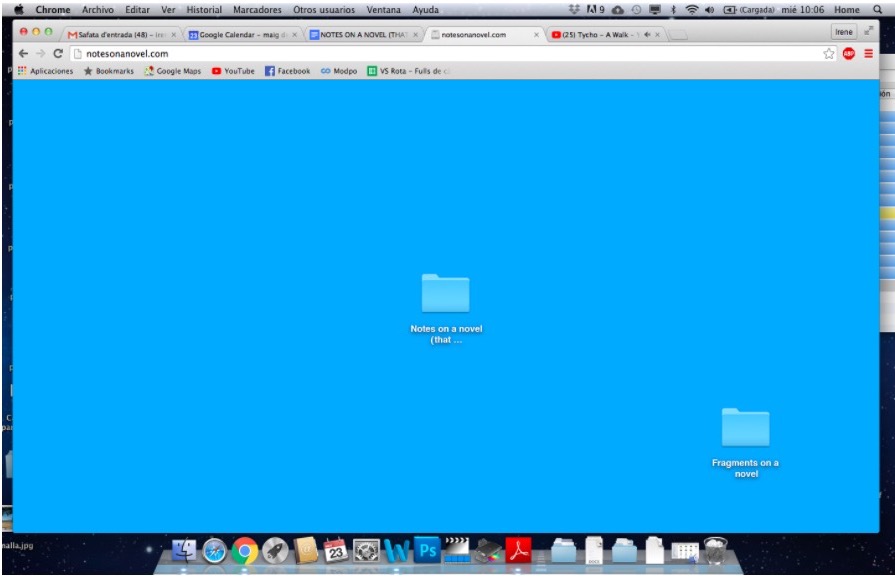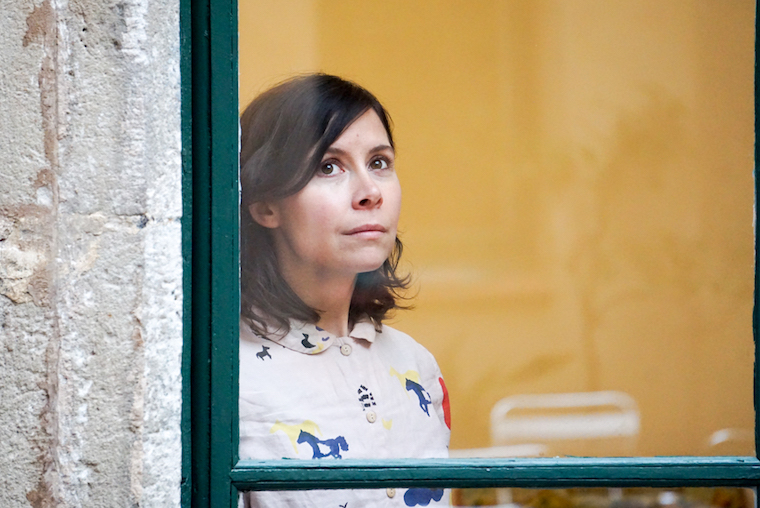Search
To search for an exact match, type the word or phrase you want in quotation marks.
A*DESK has been offering since 2002 contents about criticism and contemporary art. A*DESK has become consolidated thanks to all those who have believed in the project, all those who have followed us, debating, participating and collaborating. Many people have collaborated with A*DESK, and continue to do so. Their efforts, knowledge and belief in the project are what make it grow internationally. At A*DESK we have also generated work for over one hundred professionals in culture, from small collaborations with reviews and classes, to more prolonged and intense collaborations.
At A*DESK we believe in the need for free and universal access to culture and knowledge. We want to carry on being independent, remaining open to more ideas and opinions. If you believe in A*DESK, we need your backing to be able to continue. You can now participate in the project by supporting it. You can choose how much you want to contribute to the project.
You can decide how much you want to bring to the project.

I do believe in God. Some days. Because if you
don’t believe in God, you can not believe in the
devil either. Neither in so many other interesting
things to believe in.
He anat posant normes a les notes. (…) I ara es
veuen tan ordenades que no ho sé…
Irene Solà, Notes on a novel (that i am not
going to write) or
the swimming pool, or the
hair, the herb and the bread or the
tomato plant.
Us humans live, mostly, on the earth’s surface. Sporadically, we plunge underwater, we go into parking lots, we catch the metro, visit some underground basement or circulate in tunnels, but we tend to get out fast, seeking light and oxygen. We tend to forget the underground world —just like we forget everything we can’t see on the long-term—, or think of it as obscure, not only because it’s dark —quite literally—, but because it’s unknown to us, and because maybe it’s an instinctive way we recognise it as a place that belongs to the dead.
Among everything that’s underground and that we tend to forget, there are the telluric forces. Energies that come from water tables, mineral seams, magnetic zones, tectonic movements, ionised air. Even though neither of these things are visible, they have an impact on the earth’s surface and in the life that takes place on it.
Not everyone ignores these forces to the same extent. There are both professionals and amateurs that have been very interested. And also, the Icelanders, who not only don’t ignore them, but also recognise them and reclaim them as a special and essential feature of their land and of who they are. A part from the Icelanders, literature has covered these forces, both in traditional oral manifestations and in many of its written genres, personifying them as magical beings, interpreting them from the subconscious or describing them as supernatural forces, among other things.
Authors like Irene Solà stand out in literature, as she was able to make stories up, with boundless talent, that poetically blend the underground forces with the life on the surface, the magic influences with the ordinary progression, the energy of the living with the energy of the dead, and the energy of the animal characters and the non-human animals. All of this is clear in her three published books: the bilingual poem book Bèstia/Beast (Galerada, 2012), the novel Els dics (L’Altra Editorial, 2018) and, in a clearer way, in her most popular and awarded work, Canto jo i la muntanya balla (2019). But it is also significantly present in her metaliterary project Notes on a novel (that I am not going to write) or the swimming pool, or the hair, the herb and the bread or the tomato plant, which, even though it’s online and of free access[1], is significantly less known than her other works, maybe because it was developed in the field of contemporary visual arts[2], generally less significant than literature.
Notes on a novel contains all the features that characterise Solà’s style and literary interests, but with the particularity that, on top of that, it’s a tale (or rather meta-tale) set in Iceland, an island where, telluric forces manifest spectacularly. The underground is present on the surface of Earth, either constantly or sporadically harmonically or accidentally, in the form of geysers, natural warm pools, sulphide explosions or volcanic eruptions.
We could thus confirm that Notes on a novel is a telluric text squared. Or even cubed, a third grade tellurism, because the intentions of the author are made explicit in the novel’s meta-literary nature: the —fictionalised— relationships between her personal experiences and the way they are written, the structure of the narration and its construction: everything that, ultimately, normally goes through a novel in a subterranean way, without actually manifesting in the surface of the text.
Notes on a novel, as the title suggests, is actually not a novel, but rather a literary project formed by the multiple and varied combination of the notes that would help the author write it. Even though Solà announces in the title itself that she won’t write it —Notes on a novel (that I am not going to write)—, ironically enough, throughout this meta-referential exercise, the allegedly not written novel is built, through fragments and omissions, yes, but in such a solid and rich way that, when the reader gets to the end (a chapter called in a meta-referential way “The great end”), they may have the feeling of having reading it and having taken part in it. Solà defines it as “a project about writing in the digital contemporaneity, because all the notes for this novel are written online on a public Google Drive”. And also, as a “meta-novel made from all the fragments, dialogues, discarded material, notes, lists of ideas, etc. that haven’t been plaited”, an approach that’s also linked to the underground and to what’s telluric, where everything we bury is concentrated, everything that doesn’t germinate but that does nourish other growing things, all latent forces and energies that don’t get to emerge, and also those who do so accidentally, or too abstractly, or too unconsciously for us to make them ours, through a novel, for example. It’s an intertextual and hypertextual tale, because photographs, links to other tales, songs, music videos from the Internet, screenshots of e-mails, tour guide fragments, tales and poems by other authors are included in the novel as a reference and in recognition to all those energies and forces that inspire any creative act, that coexist and take part in it without being usually referenced explicitly.

In an interview, referring to Canto jo i la muntanya balla, Irene Solà affirmed she was interested in imagining a land covered in layers, “as if everything that happened left traces [3]“, and this is also fully suitable for Notes on a novel, a project that takes two trips the author took to Iceland as a starting point. In the text, the experiences of her first trip shape her experiences from the second one, and, at the same time, the second trip acts as a research of the traces left during the first one, as if the first incursion to the island was the substratum of the second one and at the same time, this last trip nourished the previous one and gave it some sense. Sometimes, the two trips overlap and break the chronology of the years that separate them, like a volcano making the tectonic energies of ancient times emerge (“And when we went through the North with O, years later, or years before, or in a different temporal space, or in a parallel temporal linea, and the Sun would never set”). Thus, there isn’t a rigid chronologic evolution. The narration is constantly interrupted with annotations and allusions to the present time in which the writing exercise was being developed.
Moreover, there are paragraphs that are repeated and references that resound in each other, causing echoes and circular movements, just like the two trips the author takes throughout Iceland are, through a road that allows for going around the island. Experiences and characters from the first trip emerge and are reactivated in the second one, sometimes in an almost magical way, almost as if underground forces came to the surface.

There is, indeed, a sense of verticality, a relationship between what’s above and what’s underneath, which puts us back to layers and substratum once again, and returns us to telluric forces and their own way of connecting what’s above and what’s underneath, what’s inside and what’s outside. On Notes on a novel this vertical movement of ascending and descending is clear on a combination of objects, images and suggestive phenomena, such as dark sledges full of stars, natural cold and warm pools, volcanoes, high mountains and also shooting stars that fall down on Earth from the sky; elements expelled from the underground and outer space, and in between those, the surface of Earth, to an island at the confines of our continent.
Besides these “telluric-literary” structures, Notes on a novel is also abundant on explicit telluric forces: sulphur waters, tectonic faults, volcanic movements… And also magical forces: ghosts, pixies, curses…, which could easily be a narrative translation of the first ones —the map the author fills with annotations and sends to O, whom she loves—, appear referenced to specific geographic zones (“Zone in Iceland where you can’t go because it’s full of huldufólk (hidden people), fantasmes, jarðvergar (gnomes), álfar (elves), ljósálfar (fairies), dvergar (dwarves), jlúflingar (lovers), tívar (mountain spirits) and englar (angels)”).
Irene Solà also talks about Notes on a novel as “a project about seeds that don’t grow, or about planting an apple tree and growing tomatoes”, as “a novel that hasn’t been written and everything it could have been”, and its description indicates a modest way of placing oneself on the Earth’s surface, a way of recognising the forces of the underground, and the fact they dialogue and even differ from human will. It’s interesting to think that one of the places Solà references in Notes on a novel, the Icelandic prairie Þingvellir founded the first parliament of the world. Found in the conjunction of two big continental plates, between the Arctic and Atlantic oceans, this prairie is one of the places where telluric energies manifested the most intensely. The very first debates human beings ever had, thus, must have been marked by this very same modesty Solà shows, by an underground conscience, a conscience of the fissures, of the unstable condition of the surfaces. And everything it could have been.
[2] Notes on a novel va was one of the winning projects of the Entorns digitals’ modality of the fellowship program of artistic production Barcelona Producció 2017-2018, prooguts in the art centre La Capella.
[3] Geli, C. (2019). Irene Solà: “L’art m’ha donat irreverència, un punt de bogeria literària”, El País. Available at https://cat.elpais.com/cat/2019/06/29/actualidad/1561807842_772554.html

Alexandra Laudo is an independent curator. In her projects she has explored, among others, issues related to narrative, text and the spaces of insertion between the visual arts and literature; the cultural history of the gaze; practices of resistance to the image in response to hypervisuality and oculocentrism developed from the visual arts and curatorship; and the 24/7 paradigm in relation to sleep, new technologies and the consumption of esimulants. Laudo has explored the possibility of introducing orality, peformativity and narration in the curatorial practice itself, through hybrid curatorial projects, such as performative lectures or curatorial proposals located between literary essay, criticism and curatorship.
Photo: Foto: © Ernest Gual
"A desk is a dangerous place from which to watch the world" (John Le Carré)